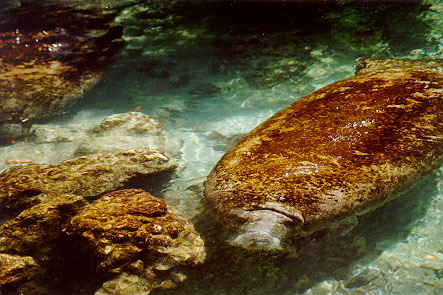 It looks like a massive, round,
algae-covered rock in the middle of a calm, clear river.
Suddenly, the rock starts to move, gliding slowly through the
crystal blue water until two flaring nostrils break the
surface. The one-ton Florida manatee dwarfs your kayak but
greets you with an inquisitive eye.
It looks like a massive, round,
algae-covered rock in the middle of a calm, clear river.
Suddenly, the rock starts to move, gliding slowly through the
crystal blue water until two flaring nostrils break the
surface. The one-ton Florida manatee dwarfs your kayak but
greets you with an inquisitive eye.
West central Florida is native habitat for manatees,
which warm their mammalian flesh in the tepid springs of the
Crystal and Homosassa Rivers during winter and ply the
waterways or head for the open ocean during the rest of the
year. For years, locals and tourists alike have been gathering
around the springs trying to get a glimpse of these gentle
creatures. Now, Susan Davis, an eco-entrepreneur who leads
paddling tours throughout the region, has a better way for
people to interact with the increasingly rare manatee. Davis
helped map out the nascent Nature Coast Canoe & Kayak
Trail, located in Citrus County, Florida--just 90 minutes
north of Tampa.
Water trails are becoming increasingly popular,
according to North American Water Trails, a recently formed
coalition of organizations and citizens committed to creating
what they call "Ribbons of Discovery" across North America.
"So many people go from car to house to job to store and
totally lose contact with nature," Davis laments. "But for
people who want to save the environment, they have to be able
to see and experience it." Marked water trails are an
excellent way to do this.
Florida's so-called Nature Coast is home to all manner
of wildlife--including river otters, alligators, dolphins, sea
turtles, manatees and more than a hundred species of birds--as
well as several wildlife preserves and refuges (46 percent of
Citrus County's land lies in federal, state or county parks
and preserves). The Canoe and Kayak trail now travels nearly
25 miles through 60,000 acres of preserve that's accessible by
water only. "It offers a true wilderness experience," says
Davis. "And depending on what kayak you're using, the manatees
are bigger than your boat, which is thrilling!"
The trail began as a local teenager's Eagle Scout
project in 1998. Ian Maidoff needed to do a service project,
and Citrus County was eager for more environmentally sensitive
ecotourism. Maidoff contacted the county's Ecotourism
Committee, on which Davis now serves, and requested help
mapping the trail and getting funds. The project was a
success, and Maidoff installed trail signs in early 1999.
The initial leg of the trail followed the 13.5 mile
length of the Salt River, part of St. Martin's Marsh Aquatic
Preserve, a water-access-only refuge for coastal wildlife. The
Salt River runs due west of Crystal River National Wildlife
Refuge. This refuge was created specifically to provide and
protect manatee habitat, because in winter 20 percent of the
Florida manatee population congregates en masse at the river's
headwaters, King's Spring. Manatees typically spend summer in
the Gulf of Mexico and the Atlantic Ocean, but a growing
number have taken to staying in the rivers year-round. In the
fall and spring, manatees migrate along the region's
interconnecting waterways, including the Salt River.
Although manatees seem plentiful in these waters, they
are a federally endangered species that struggles to survive
amidst speeding motorboats and declining habitat quality.
Florida waters were officially dubbed a sanctuary for the
manatees in 1978, and populations have slowly rebounded, but
death stats continue to rise. Despite strict speed limits
throughout their habitat, manatees are frequently killed or
maimed by boaters who ignore the speed limit. Propeller
injuries are so common that scientists use the scars to tell
manatees apart.
Eager to expand the publics' access to the waterways,
last year Davis decided to extend the trail another 12 miles
down the Homosassa River and its tributaries. The north-south
running Salt River dead-ends into the east-west running
Homosassa. After a year of planning and mapping out the route,
this second leg opens on April 21 and will be christened with
the first-ever Swamp Stomp and Paddle Biathlon, a 12K run
followed by a 5K canoe and kayak race along part of the trail.
The event served as a de facto grand opening for the entire
route.
The second leg travels around historic Tigertail
Island, an ancient Indian mound. "Seminoles and other Native
American cultures ate shellfish from the rivers," Davis
explains, "and they created huge mounds of discarded shells."
Relics of these mounds remain on the island, which was named
after a Seminole chief.
When crossing the Homosassa, paddlers may spot an
occasional house, but the trail continues into aquatic
wilderness. The rivers in this leg of the trail are rockier,
with jagged limestone outcroppings lining the banks. The trail
ends at the Chassahowitzka River in the Chassahowitzka
National Wildlife Refuge. The Chaz, as locals call it, is home
to manatees (which nurse their calves here) and soon another
endangered species. The international Whooping Crane Recovery
Team has plans to reintroduce a flock to the refuge this fall.
These majestic white birds with a red cap wade in the tall
salt grass of the coastal marshes feeding on blue crabs and
other local fare.
Davis hopes to extend the Nature Coast Trail even
further, and neighboring counties have already expressed an
interest in creating conjoining routes. "In the not too
distant future, I can see [a system of] connecting trails
throughout the state of Florida," Davis says. And, if North
American Water Trails has anything to say about it, perhaps
throughout North America.



